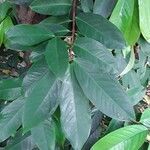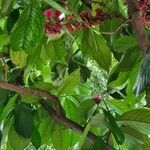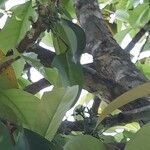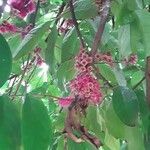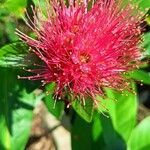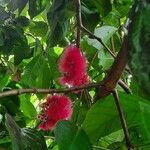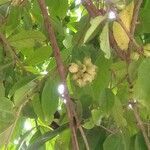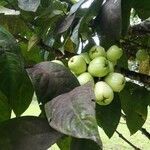An evergreen tree 5 to 25 m tall. It spreads out to 4 m across. Trees tend to branch near the base. Leaves are simple, thick and leathery and shiny on both surfaces. They are large and oval. Leaves can be up to 25-30 cm long and 12 cm wide. The leaves have a vein around the edge of the leaf. Flowers are produced on old wood and on the trunk as well as in the angles where leaves join and at the ends of branches. Flowers are purple, crimson or white and 2.5 cm across. They mostly occur in dense clusters giving a brilliant display. The red stamens are often fallen under the tree. The fruit is rounded or oblong and 5-6 cm across by 6-8 cm long. The fruit has white flesh around a large brown seed. The seed is about 1.3 cm by 1.7 cm. Some kinds are seedless. The skin of the fruit is red or pink with darker stripes. The fruit are edible.
Conical tree 6–18 m tall with dense foliage and smooth flaky bark.. Leaves very variable, oblong to elliptic, 16–34 cm long, 5–15 cm wide, acute or acuminate at the apex, cuneate at the base, subcoriaceous; petiole 0.5–1.5 cm long.. Flowers crimson in ± sessile clusters on new or old wood.. Calyx 1.5 cm long, 8 mm wide with lobes ± round, 5 mm long, 4 mm wide.. Petals elliptic, 10 mm long, 8 mm wide, obtuse.. Fruit white, yellow, reddish or pink-blotched, obovoid or oblong-pyriform, 2.5–6 cm long, scented, crowned with enlarged green sepals.
Low trees with very dense rounded crown. Leaves large, oblong-elliptical, obtuse or acute at the base, acute or acuminate at the apex, coriaceous, glabrous, 20-30 cm. long and 8-18 cm. wide, the lateral nerves in about 10-14 pairs. In-florescences lateral, few-flowered. Flowers red. Receptacle glabrous. Sepals 4-8 mm. long. Petals orbiculate, red, 14-18 mm. long. Stamen filaments red, greatly exserted; anthers yellow. Berry obovoid, about 7 cm. long, whitish or yellowish or tinged with red.
